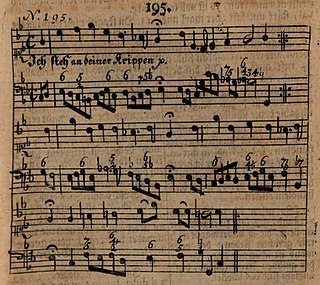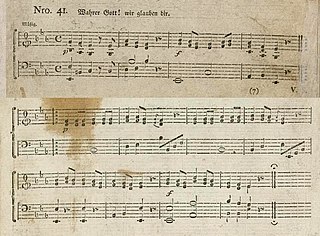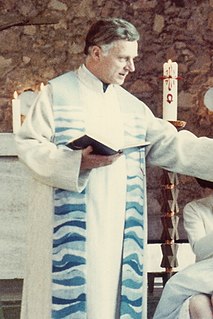Related Research Articles

Praxis pietatis melica is a Protestant hymnal first published in the 17th century by Johann Crüger. The hymnal, which appeared under this title from 1647 to 1737 in 45 editions, has been described as "the most successful and widely-known Lutheran hymnal of the 17th century". Crüger composed melodies to texts that were published in the hymnal and are still sung today, including "Jesu, meine Freude", "Herzliebster Jesu", and "Nun danket alle Gott". Between 1647 and 1661, Crüger first printed 90 songs by his friend Paul Gerhardt, including "O Haupt voll Blut und Wunden".

"Gott sei gelobet und gebenedeiet" is a Lutheran hymn of 1524 with words written by Martin Luther who used an older first stanza and melody. It is a song of thanks after communion. Luther's version in three stanzas was printed in the Erfurt Enchiridion of 1524 and in Johann Walter's choral hymnal Eyn geystlich Gesangk Buchleyn the same year. Today, the song appears in German hymnals, including both the Protestant Evangelisches Gesangbuch, and in a different version in the Catholic Gotteslob.

Gotteslob is the title of the hymnbook authorized by the Catholic dioceses in Germany, Austria, South Tyrol, Luxembourg and Liège, Belgium. First published in Advent 2013, it is the current official hymnal for German-speaking Catholics, succeeding the first common German hymnal, the 1975 edition of the same name. Each diocese published a book containing a common section and a regional section. The first editions amounted to around 4 million copies.
"Der Geist des Herrn erfüllt das All" is a Christian hymn for Pentecost by Maria Luise Thurmair, written in 1941. First printed in 1946, it appeared with a 1609 melody by Melchior Vulpius in the German Catholic hymnal Gotteslob in 1975 as GL 249. It has been included in ecumenical hymnals and songbooks.

"Nun lasst uns Gott dem Herren" is a Lutheran hymn of 1575 with words by Ludwig Helmbold. It is a song of thanks, with the incipit: "Nun lasst uns Gott dem Herren Dank sagen und ihn ehren". The melody, Zahn No. 159, was published by Nikolaus Selnecker in 1587. The song appears in modern German hymnals, including in the Protestant Evangelisches Gesangbuch as EG 320.

"Ich steh an deiner Krippen hier" is a German Christmas hymn, with lyrics by Paul Gerhardt which were first published in 1653. It was then sung with an older melody by Martin Luther, but a melody which was likely created by Johann Sebastian Bach for Schemellis Gesangbuch of 1736 is now part of current Protestant and Catholic hymnals.

"Das Grab ist leer, der Held erwacht" is a Catholic hymn for Easter, first printed in 1777 in the hymnal Landshuter Gesangbuch published by Franz Seraph von Kohlbrenner. Keeping only the first of five stanzas, with additional two stanzas, it appeared in hymnals of the 19th century, and later in different versions in several regional sections of the Catholic hymnal Gotteslob. It is a frequently sung hymn in Easter services.

""Wahrer Gott, wir glauben dir" is a Catholic hymn. Christoph Bernhard Verspoell (1743–1818), a cleric from Münster, wrote text and melody, and published it in 1810 in his hymnal Orgelbegleitung zu den Gesängen beym Römisch-kathol. Gottesdienste. Herausgegeben von C. B. Verspoell. The song in two stanzas has remained in the repertory of church hymns, used mainly during Eastertide, but also for communion and funerals. It appears in several regional sections of the Catholic hymnal Gotteslob, as GL 770 in Cologne, as GL 780 in Limburg and Münster, and as GL 783 in Speyer, among others.

"Gott, der du warst und bist und bleibst" is a Christian hymn with text by Eugen Eckert and a melody by Herbert Heine. It is also known by the title of its refrain, "Wir haben hier keine bleibende Stadt". The song was written in 1993, in the genre Neues Geistliches Lied (NGL). It appears in several regional sections of the German Catholic hymnal Gotteslob, and in other songbooks.
"Singt dem Herrn ein neues Lied" is a Christian hymn in German. It was written by Georg Alfred Kempf, a Protestant pastor in Alsace, in 1941. With a 1956 melody by Adolf Lohmann, it is part of the common German Catholic hymnal Gotteslob (2013).
"Nun singt ein neues Lied dem Herren" is a Christian hymn with German text by Georg Thurmair. He based it on Psalm 98 and wrote it in 1967 to match a traditional 16th-century melody. The song is part of German hymnals, including Gotteslob, and songbooks.

"Mit Ernst, o Menschenkinder" is an Advent hymn by Valentin Thilo. It partly paraphrases the call to penitence by John the Baptist. The text was first published in 1642 in the collection Preußische Festlieder. The different melody that later became popular dates back to 1557.

"Nun lasst uns gehn und treten" is a Lutheran hymn for New Year's Day by Paul Gerhardt. It appeared first in 1653 in Praxis Pietatis Melica. It is sung to the melody of "Nun laßt uns Gott dem Herren".
"Wer unterm Schutz des Höchsten steht" is a Christian hymn in German. The anonymous text, paraphrasing Psalm 91, appeared first in 1972 in a Protestant hymnal, with a 1537 melody from Michael Vehe's hymnal. It is contained in the Catholic hymnal Gotteslob.

"Seht, der Stein ist weggerückt" is an Easter hymn in German with text written by the Catholic priest Lothar Zenetti in 1971. With a 2011 melody by Josef Oestemer, it became a Neues Geistliches Lied (NGL) published in 2013 in the Catholic hymnal Gotteslob, as GL 783 in the regional section for the Diocese of Limburg.
"Wo Menschen sich vergessen" is a Christian hymn in German, with text written in 1989 by Thomas Laubach and with music by Christoph Lehmann. The hymn of the genre Neues Geistliches Lied (NGL) is also known by the beginning of the refrain, "Da berühren sich Himmel und Erde". It appears in regional sections of the 2013 hymnal Gotteslob, and in other songbooks.
"Herr, gib uns Mut zum Hören" is a Christian hymn, with text and melody written in 1963 by Kurt Rommel. The song, of the genre Neues Geistliches Lied (NGL), is part of German hymnals, including Gotteslob, and of songbooks.

"Nahe wollt der Herr uns sein" is a Christian hymn with German text, translated in 1971 from a 1964 Dutch hymn by Huub Oosterhuis. Its refrain says that God is among people but not recognised. The song, of the genre Neues Geistliches Lied (NGL), appeared from 1975 in German hymnals, then in the common section of the Catholic Gotteslob. In the hymnal's second edition, it appeared only in regional sections.
"Ein Danklied sei dem Herrn" is a Christian hymn with German text written by Guido Maria Dreves in 1886, and a melody written by Josef V. von Wöss in 1928. It is a song of thanks and praise of God who protects the people he created. The song appeared as part of the Catholic Gotteslob.
"Wir weihn der Erde Gaben" is a Christian offertory hymn with text by Petronia Steiner to the melody of the 1529 "Lob Gott getrost mit Singen". It appeared in the first edition of the Catholic hymnal Gotteslob and is part of its second edition. Several composers wrote settings for use in church.
References
- 1 2 "187 Wir weihn der Erde Gaben". dli-daten.de (in German). Retrieved 2 February 2021.
- ↑ "Geschichte des Nikolaus-von-Weis-Gymnasiums – Wichtige Daten und Ereignisse" (in German). Nikolaus-von-Weis-Gymnasium Speyer. Retrieved 2 February 2021.
- 1 2 "Lasst uns Gott, dem Herrn, lobsingen". evangeliums.net (in German). Retrieved 27 January 2021.
- 1 2 "Lasst uns Gott, dem Herrn, lobsingen" (PDF). bistumlimburg.de (in German). Retrieved 27 January 2021.
- 1 2 "Neue Lieder für Gott und die Welt" (PDF) (in German). Carus-Verlag. 2020. Retrieved 27 January 2021.
- ↑ Dahn, Luke (2018). "BWV 422". bach-chorales.com. Retrieved 27 January 2021.
- ↑ Voß, Herbert (2006). Lasst uns Gott, dem Herrn, lobsingen. orgelbuch.files.wordpress.com (in German).